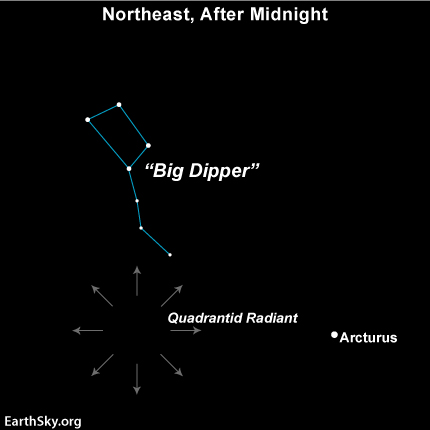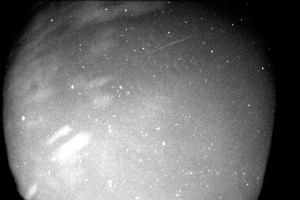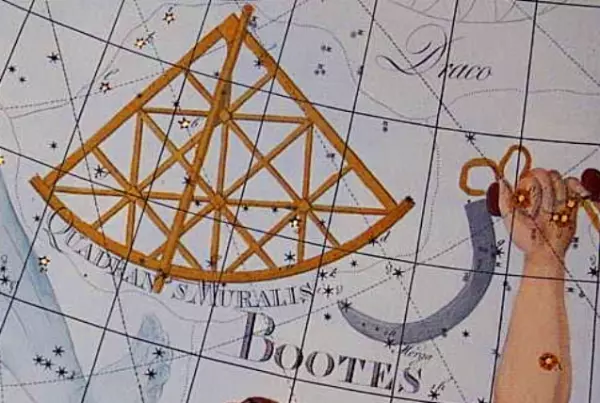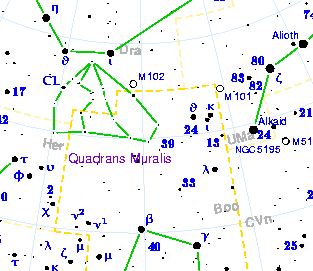The Quadrantids are an annual meteor shower occurring in the first week of January. Quadrantid meteors can be seen from January 1 to 6 and the shower usually peaks on January 3 with a zenithal hourly rate of up to 120 meteors. The Quadrantid meteor shower is best seen from the northern hemisphere, but can be observed anywhere north of 51 degrees south latitude.
The Quadrantid meteor shower has a similar peak intensity as the better known Perseids, occurring in August, and Geminids in December, but as the peak lasts only several hours, Quadrantid meteors are not seen as often as those in the other two showers. Quadrantid meteor rates exceed a half of their highest value for only about eight hours, which is relatively short. With the Perseids, for comparison, this period typically lasts for two days.

The radiant point of the Quadrantid meteor shower is near the Big Dipper asterism and the bright star Arcturus in the constellation Bootes. At the time of the Quadrantids peak each year (early January), you will find this radiant in the northeast shortly after midnight. The radiant for this shower was once considered to be in the constellation Quadrans Muralis (the Mural Quadrant), but this constellation is now obsolete. It is not one of the 88 official constellations designated by the International Astronomical Union in 1922 and adopted in 1930. Image: EarthSky Communications, Inc.
The radiant of the Quadrantid meteor shower is located in the constellation Boötes, between the Big Dipper and the asterism that marks the head of Draco. The meteors, however, can be seen anywhere in the sky from northern latitudes. The radiant is located near the point where the constellations Boötes, Draco and Hercules meet. Since the radiant is now in Boötes and not in the obsolete constellation Quadrans Muralis, the meteor shower is also known as the Boötids.
In 2003, the Dutch-American astronomer Peter Jenniskens identified the minor planet 2003 EH1 as the likely parent body of the Quadrantids. Discovered on March 6, 2003, 2003 EH1 may be associated with the comet C/1490 Y1, documented about 500 years ago by Japanese, Korean and Chinese astronomers. In 2007, astronomers theorized that the meteor shower may have originated with the disintegration of C/1490 Y1 about a century after the comet was first reported in 1490.
2003 EH1 is believed to be an extinct comet, one that has expelled most of its ice and has little volatile material left to form a tail. All that is left is rock, which makes the comet appear similar to an asteroid. 2003 EH1 is between 2.6 and 4 kilometres across and has an orbital period of 5.52 years. It came to perihelion, the point at which it is closest to the Sun, on March 12, 2014.

All sky camera image showing a Quadrantid meteor. A 4 second exposure using a wide angle lens at Ladd Observatory. Image: Michael L. Umbricht
The first recorded observation of the Quadrantids occurred on January 2, 1825, when the Italian astronomer Antonio Brucalassi reported that “the atmosphere was traversed by a multitude of the luminous bodies known by the name of falling stars.”
In 1839, Belgian astronomer Adolphe Quetelet of Brussels Observatory and American bookstore owner Edward C. Herrick from Hew Haven, Connecticut, independently suggested that the meteor shower occurred annually.
The Quadrantid shower is best observed before dawn on January 4, when the radiant is high in the sky. The waning crescent Moon will not interfere with the 2016 shower too much.
Quadrans Muralis
The shower’s name comes from the former constellation Quadrans Muralis, which is now part of Boötes. The Quadrantids radiant is located at the northern tip of the Herdsman constellation, not too far from the constellation’s brightest star, Arcturus.
The constellation Quadrans Muralis was created by the French astronomer Jérôme Lalande in 1795 and was located near the tip of the Big Dipper‘s handle, or the tail of Ursa Major, between the constellations Boötes and Draco. The constellation was named after the mural quadrant, a device mounted on walls and used to measure angles and star positions.

Quadrans Muralis constellation. Image: Uranographia, Johann Bode
Quadrans Muralis was still known in the 1820s and 1830s, when the Quadrantids were discovered and named, but fell into disuse by the end of the 19th century. Even though the meteor shower was named after it, Quadrans Muralis was not included on the list of the 88 modern constellations, created by the International Astronomical Union (IAU) in 1922 and adopted in 1930.
Quadrantids
Parent body: (196256) 2003 EH1
Radiant: Boötes constellation
Right ascension: 15h 28m
Declination: +50°
Dates: January 1 to 6
Peak: January 3
Zenithal hourly rate: 120
Velocity: 41 km/s
First record of the discovery: 1820s
